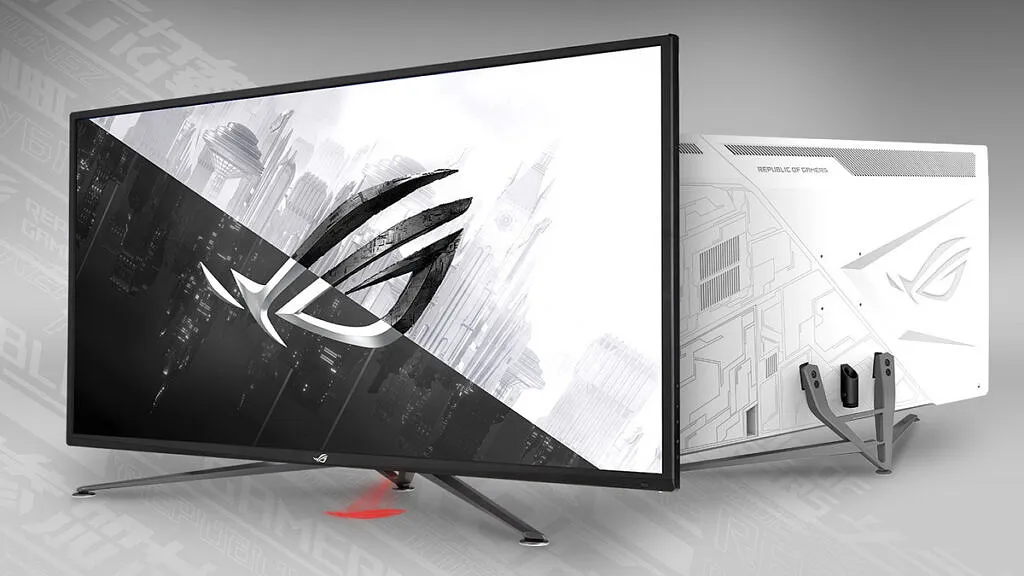Do you really want a monitor in the living room? We baulked when we saw Aorus’ 43-inch gaming monitor last month but now here’s Asus with a straight-up competitor. Which is best hdmi 2.1 monitor?
Asus ROG Strix XG43UQ Review
These beasts are designed for the living-room and offer features that a TV typically doesn’t. That means there’s no tuner and no integrated, high-quality image processor for live TV and streaming services. However, there are PC-friendly inputs, a reflection-free, matte screen, firmware which offers gaming features and the potential for a fast, 144Hz refresh rate (120Hz for consoles). You’ll need a recent, beefy graphics card to make the most of it.
The XG43UQ has some pretty nasty port placement. While on the right there are two USB-A ports, a USB-B, an HDMI port and two 3.5mm audio jacks, the remaining DisplayPort and HDMI ports are low near the base, downfacing and hard to reach without moving the monitor.
The Size
A monitor this size really isn’t great for work: moving your head around to see different parts of the screen gets tiring quite quickly. We found it best to focus attention on one quadrant and glance around at other windows on the screen when needed. Asus recommends a magnification of 300 per cent when working with Windows but this makes a mockery of the 3,840 x 2,160 resolution, as it only leaves room for one window.
However, we quickly saw why. Even with the large screen, some lettering was not as sharp as it should be – there were blurry color fringes surrounding some letters. It’s because Windows uses RGB sub-pixels for its TrueType fonts but the XG43UQ uses the reversed, TV-typical, BGR layout and Windows can’t adapt. It means that working with text and office work for prolonged periods is not particularly pleasant.
The Use
That shouldn’t be much of an issue when using the monitor for its primary job – PC gaming in the living room but there were some issues here too. The 1ms response time of the panel refers only to the cinematic MPRT rating. This, combined with the VA panel meant that some image smearing was evident. There are five (count’em) levels of overdrive to counteract this but none of them managed to hit a sweet spot.
Casual gamers won’t be too bothered but you’ll see some weird ghosting of edges in games (and movies too) because of it. Nonetheless, colors are vibrant and the 1,000-nit high-contrast, HDR ability works well with some lighting effects popping out of the screen.
Gaming OSD features include an on-screen crosshair, Dynamic Shadow Boost (to reveal enemies in dark areas), on-screen monitoring readouts and timers. You can navigate through it using the included remote, four buttons to the side or Asus’ DisplayWidget software. Meanwhile the speakers get impressively loud and offer good fidelity. The large, tripod stand is somewhat unwieldy but it’s sturdy and offers a degree of tilt.
Summary
It’s not bad, but it’s not the premium product we expect from ROG. To cap it all, there’s the price: at $2,299 it’s $600 more than its Aorus rival which performs better. There’s little reason to buy this. Average performance and poor value: not what we’re used to from ROG.
Also See;
- Best Monitors for Radeon RX 6650 XT
- Best Monitors For Steam Deck
- Best Monitors For RTX 3050
- Best Monitors For 6600 XT
- Best Monitors For RTX 3080 Ti
- Best Monitor for Radeon RX 6750 XT
- Best Monitor for Radeon RX 6950 XT
- AOC U28G2XU Review The Budget 4K 144Hz Monitor
- AORUS FV43U Review 144Hz HDMI 2.1 Gaming Monitor

